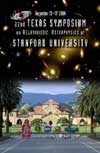Parallel A Talks: Abstracts
View Abstract Summary
0101: Rapid-Response Optical Observations of GRBs
Authors: Derek B. Fox (California Institute of Technology)
The prompt optical emission observed from the gamma-ray burst of January 23, 1999 peaked at an absolute magnitude of -37.6, a thousand times brighter than the brightest quasar, and demonstrated that the burst was produced by a relativistic bulk flow with Lorentz factor ~ 100. Recently we have observed early-time (t ~ minutes) optical emission from three additional GRBs. The emission of GRB021004 decays slowly, implying continuing input of energy to the visible regions of the blastwave for minutes to hours after the burst. The properties of the GRB021211 emission suggest that the GRB ejecta may be magnetically energy-dominated. We will discuss these results, our conclusions, and the prospects for detailed investigation of these phenomena with data and burst-triggers from NASA's forthcoming Swift satellite.
0102: The GRB-Supernova Connection: Evidence and Implications
Authors: Joshua S. Bloom (Harvard College Observatory/Harvard-Smithsonian Center for Astrophysics/University of California, Berkeley)
Early indications that the progenitors of most gamma-ray bursts (GRBs) are closely related to the death of massive stars was recently confirmed with observations of coincident supernovae signatures. I review the photometric and spectroscopic evidence for this GRB - supernova connection. The connection holds important implications for understanding the origin of other similar high-energy phenomena (such as X-ray Flashes). Using this connection as the point of departure, I also discuss the possible use of GRBs for the observations of gas and proto-galaxies in the early universe.
0103: Radio Observations and the Energetics of Gamma-Ray Bursts
Authors: Edo Berger (Carnegie Observatories)
Radio observations of gamma-ray burst afterglows provide the unique opportunity to assess the importance of mildly- and non-relativistic ejecta. Recent observations indicate that the partition of energy between the highest velocity ejecta (producing the gamma-ray event) and slower ejecta varies considerably to the extent that in some cases the gamma-ray emission is only a minor fraction of the energy budget. I will review recent developments in radio studies of GRB afterglows, their implications for the nature of the engine mechanism powering the burst, and a multi-year study of radio emission from type Ib/c supernovae which shows that, despite some similarities, these events and GRBs are produced by fundamentally different explosion mechanisms.
0104: Early Afterglow Emission from a Reverse Shock as a Diagnostic Tool for GRB Outflows
Authors: Ehud Nakar (California Institute of Technology), Tsvi Piran (California Institute of Technology/Racah Institute for Physics, The Hebrew University)
The Gamma-Ray burst (GRB) - afterglow transition is one of the most interesting and least observed GRB phases. During this phase a reverse shock propagates into the relativistic outflow (provided that the outflow is baryonic) while a forward shock propagates into the external medium. This reverse shock was suggested long time ago as the source of the optical flash and the radio flare observed in GRB 990123. We reanalyze the reverse shock emission analytically and numerically, finding new results. First we show that the relations between the optical flash and the radio flare provide a new fingerprint of the reverse shock emission that is added to the well known $t^{-2}$ optical decay (we test GRB 990123 for this signature). Future observation of this signature would indicate that the reverse shock dominates the emission during the early afterglow, implying in turn that the relativistic ejecta contains a significant baryonic component. We show farther that the light curve before the peak of the optical flash can be used as a "tomography" of the ejecta during the crossing of the reverse shock. As such it can be used to determine the initial properties of the outflow and possibly even as a test of the internal shocks process.
0105: GRB Jets Inside and Outside the Star: Precursors and Cosmological Implications
Authors: Davide Lazzati (JILA, University of Colorado)
The association of Gamma-Ray Bursts with the explosion of type Ic supernovae has settled a long debate on their origin. It also opens new questions on how the jet is born, propagates and evolves inside the exploding progenitor star. Coupling observations with theory we discuss how the young jet, while inside the star and at small distances from it,is a rapidly evolving structure. On the other hand, when the radiative phase sets in, GRB jets are fairly standard, so predictable that GRBs can be adopted as distance indicators, allowing us to put firm constraints on the evolution of the geometry of the universe with redshift.
0106: A Unified Model of Gamma-Ray Bursts
Authors: Ryo Yamazaki(Osaka University), Kunihito Ioka(Pennsylvania State University), Takashi Nakamura, Kenji Toma(Kyoto University)
Taking into account the recent suggestion that a short gamma-ray burst (GRB) looks like the first 1 s of a long GRB, we propose that the jet of a GRB consists of multiple subjets or subshells (i.e., an inhomogeneous jet model). The multiplicity of the subjets along a line of sight n_s is an important parameter. If n_s is large (>>1) the event looks like a long GRB, while if n_s is unity the event looks like a short GRB. If our line of sight is off-axis to any subjets (n_s=0), the event looks like an X-ray flash or an X-ray-rich GRB.
0107: The Cooling Behavior of Thermal Pulses in Gamma-Ray Bursts
Authors: Felix Ryde (Stockholm University)
We discuss GRBs that have very hard spectra, consistent with black-body radiation throughout their duration. We find that the temperature decay during a pulse can be described by a broken power-law in time. After the break, most cases are consistent with a decay with index -2/3. Some pulses are better modelled with a combination of a thermal and a non-thermal component with the latter component getting more important with time. We interpret the observations within a model of an optically thick shell that expands adiabatically. The slow temperature decrease is from the acceleration phase, during which the bulk Lorentz factor increases, and the faster temperature decay is reached as the flow saturates and starts to coast with a constant speed. We also discuss a Poynting-flux model, in which the saturation radius is reached close to the photosphere.
0108: Polarization in GRBs
Authors: Jonathan Granot (Kavli Institute for Particle Astrophysics and Cosmology (KIPAC))
The controversial detection of a very high degree of linear polarization in the prompt gamma-ray emission of GRB 021206 has dramatically increased the interest GRB polarization, both in the prompt emission and in the afterglow. Polarization measurements can probe the structure of GRB jets as well as the magnetic field structure in the ejecta and in the shocked external medium. This in turn can provide clues to whether large scale ordered magnetic fields take an active part in accelerating and collimating GRB jets. I discuss the theoretical expectations for GRB polarization, confront them with recent observations and mention some prospects for the future.
0109: Relativistic Outflows From Remnants of Compact Object Mergers and Their Viability for Short Gamma-ray Bursts
Authors: M.A. Aloy, H.-T. Janka and E. Mueller (Max-Planck-Institut fuer Astrophysik)
We present the first general relativistic hydrodynamic models of the launch and evolution of relativistic jets and winds, driven by thermal energy deposition, possibly due to neutrino-antineutrino annihilation, in the close vicinity of black hole-accretion torus systems. The latter are considered to be the remnants of compact object mergers. Our two-dimensional simulations establish the link between such mergers and future observations of short gamma-ray bursts (GRBs) by the SWIFT satellite. They show that ultrarelativistic outflow with maximum terminal Lorentz factors (Gamma) around 1000 develops for polar energy deposition rates above some 1048 erg/s per steradian, provided the merger environment has a sufficiently low baryon density. Due to the collimation by the dense accretion torus the typical semi-opening angles of the Gamma > 100 cone are 5-10 degrees, corresponding to about 0.4-1.5% of the hemisphere and apparent isotropized energies (kinetic plus internal) up to ~10e51 erg. 10-30% of the deposited energy are transferred to the outflow with Gamma > 100. Our models confirm the viability of post-merger BH-torus systems as engines of short, hard GRBs and can explain the durations of all observed short GRBs, because different propagation velocities of the front and rear ends lead to a radial stretching of the ultrarelativistic fireball before transparency is reached. The ultrarelativistic flow reveals a highly non-uniform structure with Lorentz factor variations up to factors of a few, caused by the action of Kelvin-Helmholtz instabilities that originate at the fireball-torus interface.
0110: Theory of a GRB Neutron Rich Fireball
Authors: Elena Rossi (Cambridge Univ., UK)
Current GRB engine model naturally predict a neutron rich outflow. I discuss the consequences of adding a neutron component to a matter dominated GRBs fireball. The complete dynamical and thermodynamical early evolution of the outflow is presented and extended to the case where internal energy is partially in magnetic field.


